The true story of outlaw queen Belle Starr, a frequent visitor to Fort Smith from Younger's Bend in the Indian Territory; documented by traditional genealogy research

The true story of outlaw queen Belle Starr, a frequent visitor to Fort Smith from Younger's Bend in the Indian Territory; documented by traditional genealogy research |
 |
| |Home| |Fort Smith Home Page| |Local History Menu| |Genealogy Menu| |
| <<=PREVIOUS | ||
The Legend of Belle Starr - Queen of the Oklahoma Outlaws |
||
What many of us think we know about Belle Starr is largely the product of fiction.The legend of Belle Starr did not take off in earnest until after her death in 1889. Writers attempting to turn a good story into a sensational one, reported rumor as fact and in some case completely manufactured stories about her. Newspapers in and around the Indian Territory became interested in her only after her arrest and conviction, along with her husband Sam Starr, for stealing horses in 1882. Newspaper writers did not have modern sensibilities about accurate and impartial reporting. They often accepted the word of their subject and acquaintances at face value. Many of the stories about her come from her daughter, Rosie Lee "Pearl" (Reed) Starr. Pearl operated brothels in Fort Smith and Van Buren up until World War I. Enhancing her mother's image as an outlaw may have been good for business. He name change from Reed to Starr appears to be an attempt to capitalize on her mother's notoriety.The research I have done on Belle Starr is what I would do normally in my genealogy research. I looked at the U.S. Census returns, death and marriage records for Missouri, Texas, California and the Indian Territories. I have read several different versions of her life, including some that took a hard look at the historical evidence. I try here, using my own judgment to separate the fact from the myth. Glenn Shirley's, Law West of Fort Smith, University of Nebraska Press, Lincoln, NE., (1957) is an engaging account of the Queen of Outlaws. "Law West of Fort Smith" is a mostly factual book primarily about Judge Isaac Parker and his court. There are chapters devoted to some of the more infamous outlaws that appeared before Parker's court. One chapter is devoted to Belle Starr and recounts the usual stories about her. In his book published in 1955 Glenn Shirley did not have easy access to many of the records we do today. I have little doubt he had access to sources that I do not. |
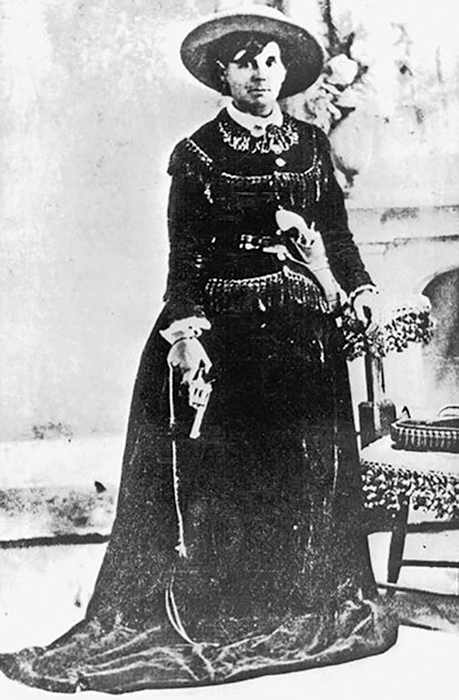
A studio portrait of Belle Starr probably taken in Fort Smith in the early 1880's. |
|
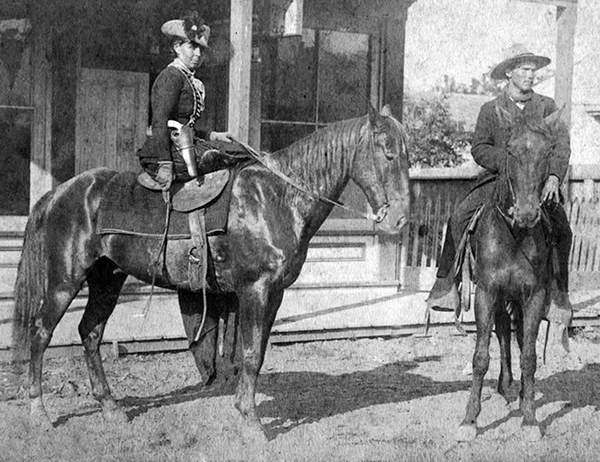
Belle Starr on her favorite horse Venus in Fort Smith about 1886 |
To better understand the upbringing and family circumstances bare with me as we look the records of Belle's family. Eliza Shirley was twenty years younger than her husband. John was born between 1794 and 1796 in Virginia. Eliza, also a Virginia native was born around 1816. Age gaps such as this are usually indicators that Eliza was not John's first wife. John Shirley and Eliza Pennington were married in Greene County, Indiana on May 29, 1837. Eliza was a descendant on her mother's side to the Hatfields of (West) Virginia, which explains why some say she was Eliza Hatfield. Their daughter Charlotte was born in Iowa in 1838. Migration from Virginia, Indiana to Iowa then south to Missouri or Arkansas was a common path of western migration in the first half of the 19th century. The Shirley family came to Carthage, Missouri between 1838 and 1842. John Shirley was not a rich man in 1850, but ten years later he had managed to become wealthy hotel owner. I find it interesting that also living and farming in Jasper County was twenty-four year old Preston Shirley, born in Iowa in 1826 when the older Shirley was around thirty years old. Perhaps this Preston was John's son by an earlier marriage. The John Shirley household in 1850 included children Charlotte A., age 12; John A. M., age 8; Myra, age 2; Benton, 9 months.Belle Starr was born Myra Maybelle "May" Shirley in Jasper County, Missouri on February 5, 1848. Her father was by then a fairly successful hotel keeper in Carthage. The 1860 census of Carthage lists Belle's father John, age 66, born in Virginia, occupation hotel keeper and an estate of $10,000, a princely sum in 1860. Also listed are: Elizabeth, wife age 45, also born in Virginia; son Allison, age 18, born in MO; Myra, age 12; Edwin, age 11; Mansfield, age 8; Cravens, age 2. Allison is obviously Belle's brother John A. M. Shirley who joined a rebel band at the start of the Civil War. |
|
Belle's father sent her to the female academy in Carthage where she was educated and learned to be an accomplished piano player. Wealthy families through out the South, often sent their daughters off to female academies to become gentile ladies. But even the best in schooling for southern ladies could not tame the wild independent streak in Belle. Despite her gentile schooling, she somehow learned to be a dead shot with a pistol and rifle and an expert horsewoman. Her brother John "Bud" Shirley was part of a small independent band of southern guerrillas. Supposedly, it was through her brother that the Shirley family became acquainted with William Clark Quantrill and his followers, including Cole Younger and the James brothers. Southern sympathizers like the Shirley's often provided Confederate guerrillas. with support and comfort. Quantrill's Raiders were only one of these. Several gangs of bushwhackers roamed southwestern Missouri and northwestern Arkansas unaffiliated with Quantrill's Raiders. Although not impossible it is unlikely the Shirley's knew Quantrill and his band of cut throats except by reputation and rumor. Quantrill operated mostly in Jackson County many miles north of Jasper County.It may be fifteen-year-old Belle did idolized Quantrill's Raiders and saw them as gallant heroes of the South, as did many Confederate sympathizers in Missouri. In the Summer of 1863 Federal troops killed Bud Shirley and razed the town of Carthage. Belle became inflamed with anger and a desire for revenge. She joined a small cadre of female spies that supplied Confederate guerrillas with information on Union troops.The story of Belle's association with Quantrill is most likely from the imagination of daughter Pearl. I have done quite a lot of research on Quantrill's Raiders for this website, including the reunions held for years after the war. A roster of known raiders is available on the Internet. None of these sources make any mention of a John "Bud" Shirley or any female raiders. William Quantrill did have a mistress, but she was not Myra Maybelle Shirley. Claims that she was is one of the many fictitious stories circulating about her after her death. It may be true Belle herself exaggerated her connection and love affair with Quantrill and Cole Younger. Her cabin was located at Younger's Bend, but other than sensationalized stories published after he death there are no documents showing Belle ever met Cole. There is even doubt that Younger's Bend was named for him, rather for a local settler who had nothing to do with the Missouri Younger's. Long after her death rumors were circulating about Belle Starr, her daughter Pearl and the former James gang outlaw.It is not likely that Belle rode off to be with Quantrill. She is not mentioned in any of the memoirs of former guerrillas written after the war. A sixteen-year-old female who could ride and shoot like the best of them would probably have been remembered, especially if she was the mistress of William Clarke Quantrill. It is entirely possible that Belle did pass relay information about Federal troops to Confederate guerrillas. Many female relatives of guerrillas did do that, and got away with it because early in the war a woman did not raise much suspicion. As the war progressed, that would change. It was in June, 1864 that Belle's brother John was shot and killed by Union militia as he tried to escape from a house the soldiers had surrounded.John Shirley moved his family from Missouri to Texas in 1864 soon after his son John "Bud" Shirley was killed. By 1870 John Shirley was again a man of moderate means. Census and other records confirm That the Shirley family was in Dallas in before 1870. In 1870 the family consisted of J. Shirley, age 72, farmer born in Virgina living in Precinct 5, Dallas County, Texas, his wife Elizabeth and sons Mansfield and John A. The war and his loss of wealth was motive enough for John Shirley to move his family to Texas, settling near Mesquite and Scyene east of Dallas. He put Belle back in school with the hope that the sixteen-year-old would become a proper lady.In 1866 the James and Younger brothers were accused of robbing the Liberty, Missouri bank, committing the first peacetime daylight bank robbery in history. The Belle Starr legend claims that Cole and the James boys came to the Shirley ranch in Texas to hide out after the robbery. When they left several months later to return to Missouri, Belle was pregnant with Cole's baby. This story is a complete fabrication. After his parole from a Minnesota prison in 1902 Cole denied rumors that Belle's daughter Pearl was his child. He claimed that at the time of the Liberty hold-up he was still in California where he had gone shortly before the end of Civil War. Cole Younger stated he did visit the Shirley ranch in Texas in 1864 during one of the guerrillas' visits to Texas during the war. The second and last time he met Belle was in 1868 when she was living with her husband Jim Reed in Bates County, Missouri. At the time she was pregnant with her first child. |
||
After 1868 Belle never saw Cole again. He was captured and went to prison in Minnesota after the disastrous Northfield raid in 1871. By the time Cole was released from prison, Belle was dead.On November 1, 1866 Myra Maybelle Shirley married James C. Reed, a former Quantrill guerrilla whom she may have known in Missouri. A marriage record exists for Mina [Myra] M. Shirley and James C. Reed in Collin, Texas, dated November 1, 1866. It was by him, not Cole Younger, that she became pregnant. Daughter Rosie Lee Reed, who Belle called "my little Pearl" was born in September, 1868 in Missouri. Belle's only connection to Quantrill was through Jime Reed's membership in the Raiders.This is source puts to rest the story of Belle becoming pregnant out of wedlock by Cole Younger. More fabricated history for Belle says that after her daughter's birth she left the child with Belle's parents and went to Dallas where she became a saloon and dance hall singer and piano player. She also learned to deal poker, Monte and Faro. It is said she became financially independent and dressed extravagantly and mixed with men who had less than total respect for the law. Perhaps daughter Pearl's love of enhancing her mother's bandit career was the source of the fictious story, which became part of her mother's legend. If Belle and her husbands became financially independent while they lived in Dallas, that wealth had vanished by the time the Reed family moved to California.According to legend, twenty-eight year-old Jim Reed was known around Dallas as a horse thief. It is said that Belle operated a stable where she sold horses that Jim stole. When Belle became pregnant with son Ed Reed, Jim Reed took Belle and Pearl back to his home in Missouri, perhaps to visit relatives before leaving for California. Reed joined a gang of Texas cattle rustlers ambushing Texas herds headed to Kansas. Belle must have known of her husband's career; if she did not actually participate, she never begged him to quit his lawlessness. Jim's brother Scott Reed was killed by the Shannon brothers, members of another gang of cattle rustlers. Jim Reed sought revenge. He shot his brother's murderers and warrants were issued for his arrest. He fled to California later sending for Belle and Pearl. If the legends of the Reed family are true, Jim Reed and wife Maybelle must have been a busy couple from the time of their wedding 1866 until their departure from Texas to a safer location where lawmen before 1870. I can find no brother Scott in the Reed family in the census for Missouri, so it is impossible to confirm this part of the story. |
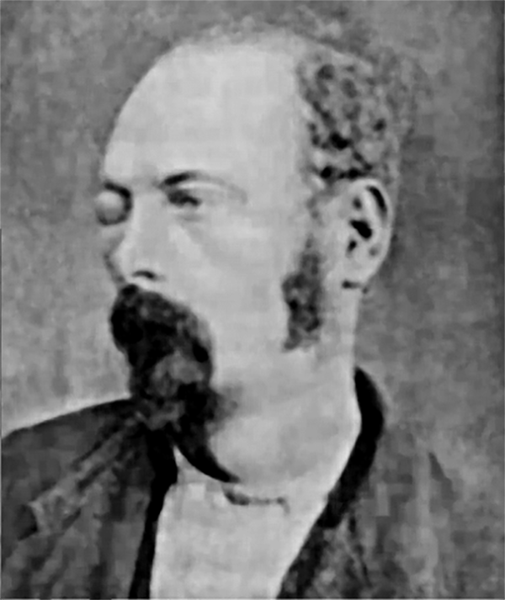
Cole Younger immediately after his capture in Minnesota in 1871. His right eye is badly swollen from a beating he received when the Northfield posse ended his criminal career. |
|
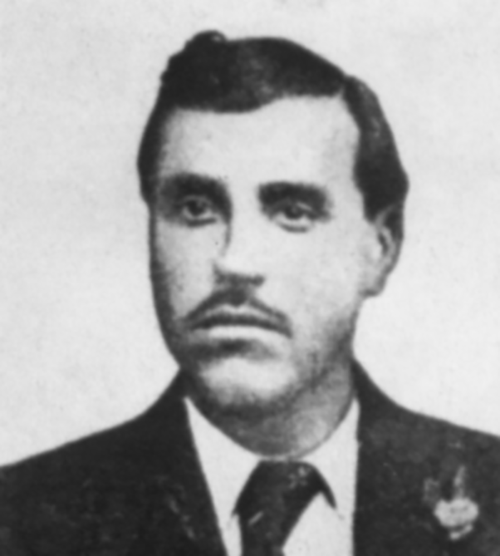
Belle's son Ed Reed |
The story of Belle and Jim raising hell in Dallas in the 1860's is fictitious.
Jim Reed took his pregnant wife back to his family's home in Bates
County, Missouri shortly after their marriage. There is no
evidence that in the early years of their married life Jim or Belle were associated with any
shady activity or living a scandalous life in Dallas. However,
after returning to Missouri Jim Reed became involved with Tom Starr
and whiskey smuggling in the Indian Territory. A warrant for
his arrest was issued for the killing a man named Shannon, which could well have been revenge for the murder of his older brother
Scott. The 1850 and 1860 censuses of Bates County, Missouri lists the family of Solomon and Susan Reed, Jim's parents. They do
not show a child named Scott. Perhaps it was the middle name
of Jim's brother, William.
The second child born to Jim and "Mary" M. Reed was a girl named Elisa, born in 1870 in California. Belle's third child James Edwin Reed, was born in Los Angeles County, California in 1871. When I looked at the 1870 census for Los Angeles County, California I found Jim Reed (age twenty-four, born in Missouri) and his family living in Los Nietos. I was surprised to find daughter Elisa W. Reed, born in April, 1870 in California. This child must have died at a very young age, very common tragedy in the 19th century. The census list Myra Maybelle as Mary M., age 20, and born in Missouri. Daughter Rosa (Pearl), age two, is listed with the unlikely place of birth, Maryland (we often see errors such as this on census records). In the household with the Reeds is Henry Reed, age 35, born in Kentucky. I'm certain that despite the errors, this is Jim and "May" Reed. Since the Reeds moved to Missouri from Kentucky, Henry is probably a cousin. James Reed's personal property is listed as $900, a respectable amount for a farm laborer, suspicious for someone seemily so adverse to honest labor. Nine hundred dollars would be comparable to a year's income for some families in today's dollars. His fortune may have had a lot to do with his secret part-time jobs, counterfeiting and robbery. |
|
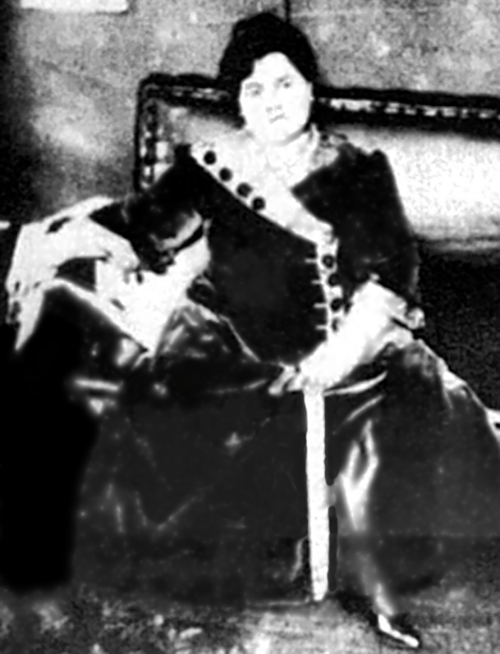
Belle's daughter Rosa Lee (Pearl) when she was a madam in a Fort Smith bordello in the 1890's |
Having a wife and three children to care for did not deter Jim from escalating his outlaw career in California. Reed held up a stage near San Diego while involved in counterfeiting. Eventually, California law enforcement learned of the warrant out of Missouri for his arrest. Awards rewards offered for his capture made him a valuable target for bounty hunters. He was again forced to flee.Belle supposedly returned to Texas with Pearl and Ed about 1873. History books never mention the other daughter. Belle's father took her in for the sake of his grandchildren. Jim Reed went into hiding in Indian Territory at the ranch of notorious Cherokee outlaw Tom Starr. Belle would travel to Indian Territory to visit her husband on the Starr ranch. Thus her long association with the Starr's.Tom Starr had been a strong advocate of the Southern cause. After the war he stirred up enormous trouble for the Cherokee Nation and the Starr clan began a long crime wave of murder and robbery, untouchable by the law. Tom Starr and his sons were such a large and powerful force in the Cherokee Nation that the tribe was forced to sign a treaty with him. In exchange for peace the tribe paid him a good chunk of their treasury and gave him a large section of land in the area of Eufaula on a bend of the Canadian River. The area was remote and scarcely populated. No one dared travel the area unless they knew or were invited by the Starr clan. It became a refuge for some of the most notorious outlaws in the West.The Belle Starr legend says that In the fall of 1873, disguised as a man she went with her husband and outlaw Daniel Evans to the home of Watt Grayson, a wealthy Creek who lived not far from Tom Starr. The outlaws beat and tortured Grayson and his wife until they told the bandits where they had hidden $30,000 in gold coins. This is an incredible story. the result of fabrication or rumor, not fact. The Grayson's identified Reed and one accomplice, but said nothing about a woman dressed as a man. They were brutalized for several hours and most people would think that the Grayson's would have noticed something unusual about one of the outlaws. |
|
At a time when the average annual income of most families was well under $1,000 a year, $30,000 was an enormous amount of money, even split three ways. The Reeds could have lived comfortably on their share for many years without committing another crime. But, criminals are usually greedy and the motive for their crimes is not always just the money.There was nothing the Grayson family could do about the crime. The Federal Court for the Western District of Arkansas under Judge William Story with jurisdiction, had no interest in chasing outlaws in the Indian Nations. The tribal police had no authority to arrest non-Indians, or even other Indians not of their tribe. Cherokee police could only investigate and arrest a Cherokee for a crime against another Cherokee. There was indeed no law west of Fort Smith that could touch the criminals before 1875 when Isaac Parker was appointed Federal Judge for the Western District of Arkansas.In 1874, while Jim Reed was visiting Belle and the children at the home of Belle's father, he joined up with two of his old gang members and held up the San Antonio stage. Reed's accomplices were captured in Dallas and a few months later Reed was killed by a deputy sheriff near Paris, Texas.Up until then, Myra Belle Reed was only known in a few circles as the wife of an outlaw. She would soon start the chapter in her life that would make her notorious in her own right. Belle supposedly shipped Ed and Pearl off to relatives in Missouri and Arkansas for a time and moved to Indian Territory. She became involved with her husband's old gang of cattle rustlers, bootleggers, hold-up artists and horse thieves. She soon made herself the power behind the outlaws. Some claimed Belle planned their robberies and helped to fence the spoils. If a gang member were caught, Belle would finance the lawyers or bribe officials to free them. According to some she rewarded the most successful outlaws with sexual favors. I find that hard to believe based on her treatment of unmarried daughter when Pearl became pregnant. If any of this were true, she was a woman who knew how to control men and she was not timid about it. As an outlaw she could be what very few women of her time could be, totally liberated and unbounded by the Victorian morality of that age. However, I do not think that there is much evidence to support most of these claims.I wonder how anyone would know about Belle's sexual activities. I suspect that those tales were mostly rumor about a single women living among men who had little regard for other social mores. I also suspect that Belle's daughter Pearl Starr, who was a madam of Fort Smith brothels until World War I, may have used these stories about Belle to enhance her own image - or maybe a back-handed slap at her mother's puritanical attitudes about sex. Belle attempted to get custody of Pearl's illegitimate daughter Flossie because she disapproved of her daughter's prostitution. Before Flossie was born Belle tried to get Pearl to have an abortion rather than give birth to an illegitimate child. Supposedly, Belle told Pearl that if she had the child she would kick Pearl out of the house and she never wanted to see the child. This does not sound like a sexually promiscuous woman to me.Belle had met Sam Starr during her visits to her husband's hideout in 1873. If Starr was one of Belle's many lovers during the days of her leadership of the outlaw gang, it is completely out of character for a woman a puritanical attitude about sex. Belle married Sam Starr in 1880 and gained her famous name. While Belle Reed may have been a respectable outlaw name, Belle Starr had a ring to it that the press and dime novelist could not pass by.Now that Belle had married a Cherokee she had dower's rights to her husband's land. Sam Starr had a place on a bend of the Canadian River near Porum, Oklahoma under Hi-Early Mountain. Belle promptly made it her home and legend has it she renamed it "Younger's Bend" in honor of Cole. The place could only be accessed through a narrow trail running through a canyon with caves and boulders used to guard the entrance. The ranch was practically impenetrable and immediately became a refuge for any outlaw seeking a hideout. This description is a Hollywood screen writer's dream of an outlaw hideout. I have been to the general area of Younger's Bend, which is near Lake Eufaula in Haskell County where I own a small parcel of land. I do know the general area. The place is not so isolated or secure to make it impenetrable. There is no canyon with caves or a single entrance to guard. There are dozens of different ways a person on a horse could get to her cabin even in the 1870's. U.S. deputy marshals and Cherokee tribal police raided Younger's Bend and Belle's cabin more than once. Lawmen had no problem finding it or surprising the occupants. The origin of name of Younger's Bend is disputed. Some sources say that it was Tom Starr who named it in honor of Cole Younger who may have hid out there during the Civil War while Quantrill's Raiders were in Texas. If so, it bore the name long before Belle Starr ever lived there. There is some evidence that it may have been named for a local settler named Younger unrelated to the Missouri Younger family.In 1882 the law finally caught up with Belle and Sam Starr. They were arrested for horse theft; two horses belonging to neighbors somehow mysteriously wandered into the Starr corral and Belle and Sam sold the horses as their own. The pair was arrested by U.S. Deputy Marshals and taken to Fort Smith to face Judge Isaac Parker. Both were found guilty and sentenced to a year in the federal prison in Detroit. Nine months later both were paroled, back in Younger's Bend and back to their old ways.It was well known that outlaws sought refuge at Younger's Bend and Belle welcomed them all. She made that statement to a Dallas newspaper reporter in the 1880's, some time after she returned home from prison in 1884. Perhaps she felt that if she was to be labeled an outlaw, she might as well make the best of it. From this period until her death Belle never seemed to be hard up for money. |
||
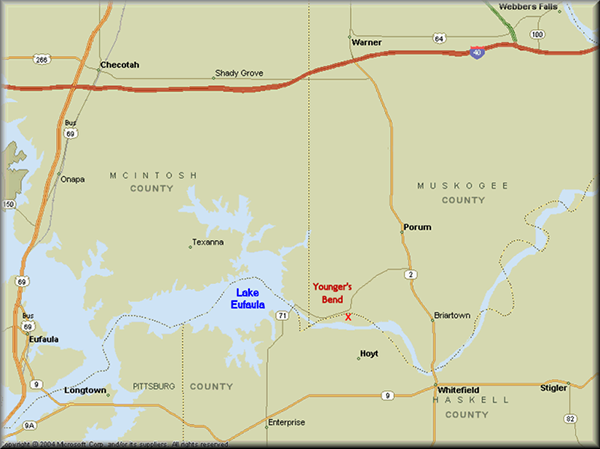
Map of present day Oklahoma showing the location of Younger's Bend |
Some time after their return to Younger's Bend a cousin of Jim Reed,
John Middleton, sought refuge at the Starr ranch. Middleton was
a wanted man in Arkansas and Texas. He had fled Arkansas after
gunning down Sheriff Black of Lamar County, Arkansas at Black's
front door. In the spring of 1886 a warrant was issued for
the arrest of Sam Starr and others, including John Middleton for the robbery of the Creek and Seminole Nations treasuries.
A posse raided Younger's
Bend looking for Starr and Middleton, and evidence to tie them to the robberies.
The pair were not at the ranch when the marshals arrived and the posse
found nothing to implicate them in the hold-ups. With the heat on
at Younger's Bend, Middleton decided to go back to his mother's home in Dardanelle,
Arkansas. He asked Belle and Sam to help him. They hid Middleton
in a wagon covered with a tarp, with their saddle horses tied to
the back and the children little Ed and Pearl in the wagon, the troop headed for Arkansas. They camped for the night on
the first day out near Keota, Indian territory. Middleton said something to offend Belle
and she refused to go any further. Belle also denied Middleton's request to borrow her horse.
However, Belle purchased a mare for Middleton from a local man the following day and gave Middleton her saddle and .45 revolver. After Middleton left the group the Starr family returned to Younger's Bend. Several days later the mare was found, covered in mud and with Belle's saddle still on her. A search soon led to Middleton's body in the mud on the banks of the Poteau River near the Arkansas border. The consensus was he had drowned while attempting to cross the unusually high water in the river. About this same time three people robbed elderly N. H. Farrell and his sons some forty miles west of Fort Smith. Rumors spread that one of the three bandits was a woman dressed as a man.In April, 1886 writs were issued for Belle and Sam's arrest for the robbery. In May U.S. Deputy Marshals again raided Younger's Bend looking for Sam and Belle. When the posse arrived at Younger's Bend Sam was gone but the officers arrested Belle and took her back to Fort Smith to again face Judge Parker. Belle pleaded not guilty. At Belle's trial, old man Farrell and his sons were unable to identify Belle and testified that the robbers were three well built men. Belle was acquitted. Belle's troubles were not yet over. The horse that Belle bought for Middleton was stolen. Marshals again arrested Belle and she again faced Parker for horse theft. Belle testified to the circumstances and once again the jury acquitted her.In September, 1886 Sam was wounded and captured in a corn field by tribal police. While his wounds were being tended to, some of Sam's friends raided the farm house where he was being held and freed him. Sam hid out to recover and Belle tended to his injuries. When she learned that the tribal police were planning yet another raid on Younger's Bend, she convinced Sam to turn himself into U.S. Deputy Marshals. She convinced him that he would stand a better chance in front of Judge Parker than before the tribal council. If he turned himself in to the marshals, she argued, the tribal police could not arrest him. It was good advice and Sam took it. Sam rode into Fort Smith and surrendered himself to startled deputy marshals who had been hunting him for months. Belle hired the best lawyers in Fort Smith for Sam and paid his bail. He was released on bail and returned to Younger's Bend to await his trial. Sam did not live to face Parker. He was killed in a gunfight with a tribal policeman at a dance he and Belle were attending one week before Christmas. | |
With Sam dead Belle now had a big problem. The Cherokee tribal council told her that her claim to the land at Younger's Bend ended with Sam's death. She was in danger of losing her home in the Indian Nations. Belle solved her problem by marrying young Jim July, a mixed blood Creek and Cherokee Indian and the adopted son of old Tom Starr. He was entitled to own land in the Cherokee Nation. It is impossible to know is what Jim July gained from this marriage. He was more than a decade younger than Belle. July would say very unflattering and disparaging things about Belle when with his friends. Perhaps it was her money that interested him. The marriage did not sit well with Belle's son and daughter who both resented July. Young Ed was very upset by the marriage and often quarreled with July.The marriage was the beginning of Belle's problems with her children. Pearl became pregnant by a married man she had been seeing behind Belle's back. Belle tried to convince Pearl to have an abortion by a Fort Smith doctor, but Pearl refused. Belle shipped Pearl off to her grandmother in Siloam Springs, Benton County, Arkansas to have the baby. After the baby was born Pearl returned to Fort Smith and eventually drifted into prostitution. Belle was outraged at her daughter's behavior and tried to have the baby taken away from her. While Pearl was still in Arkansas her brother Ed was arrested for horse theft and selling liquor to the Indians. Belle hired lawyers but Ed was sentenced to prison. A few months after Ed was incarcerated, Belle's lawyers were able to win a pardon for him and he returned home to his mother's ranch. There are at least two versions of what happened next. One says that Belle soon suspected her son was intercepting her mail and asked the postmaster to give her mail only to her in person. When Ed tried to pick up Belle's mail, the postmaster refused. Reed pulled a gun and demanded he hand if over. Belle walked in at that moment. She had a bull whip with her and commenced to lash her delinquent son with it, giving him quite a severe beating. That is one version. Another says that Belle caught Ed mistreating one of her horses at Younger's Bend. She gave him a lashing with a bull whip that he brooded about for months. It is, of course possible that both events are true. Whatever the story, Ed soon moved out of the cabin at Younger's Bend.In 1888 Edgar A. Watson and his wife moved to the Canadian River in Indian Territory from Florida. Watson rented some land from Belle and paid cash in advance. Later, Belle heard a rumor that Watson was wanted in Florida for murder. The Cherokee tribal council warned Belle after their last raid on Younger's Bend if she was caught again harboring outlaws or fugitives they would put her off her land. Fearing this, Belle went to Watson and tried to return his money. He refused to accept it and said he intended to farm the land he had paid for. Belle was upset but there was nothing she could do.Things went from bad to worse for Belle. About the same time Ed was arrested for stealing horses, Jim July was also indicted for horse theft. On February 2, 1889, July left Younger's Bend to turn himself in at the jail in Fort Smith. Belle accompanied him a dozen miles or so, then turned around to go home after the two got into an argument. Belle told Jim she would not pay for his bail or his lawyers. On the way back to the Bend she stopped at a neighbor's house to visit with the wife of a friend and see her son Ed who was staying there. Watson at the house and the argument between him and Belle resumed. During the quarrel Watson made a remark about how often the law seemed to be at Belle's ranch. Belle responded saying perhaps the authorities in Florida would be interested in knowing where Watson was.Belle mounted her horse and rode back towards her cabin. As she was crossing the creek near her cabin, a blast of buckshot hit her in the back knocking her off her horse. She tried to get up when another blast of turkey shot hit her in the face and neck. Two men at the Canadian River ferry where Belle had crossed a few minutes before heard the two shots. One of the men, Milo Hoyt, ran up the road towards Younger's Bend and found Belle face down in the mud. When she lost her rider, Belle's beloved horse Venus ran off towards home. The horse with its blood covered saddle reached the cabin and Pearl immediately knew two shots were meant for her mother. Pearl ran down the trail to where Hoyt was trying to comfort Belle. Belle died in her daughter's arms. Pearl and her neighbors buried Belle by her cabin in Younger's Bend. Pearl purchased a headstone for her mother's grave at Younger's Bend and it stands there now.Now began a murder mystery worthy of the best fiction. At first it seemed a clear cut case against Edgar Watson. When Jim July reached Fort Smith a telegram was waiting for him with the news of Belle's death. He immediately started back for Younger's Bend arriving there the following day. Boot tracks were found leading towards Watson's cabin. When Watson's house was searched the men found his shotgun and both barrels recently discharged. Watson denied having anything to do with the murder. July threatened to kill Watson and Watson replied that if Jim did that he would be killing an innocent man. Watson agreed to accompany Pearl, July and other witnesses back to Fort Smith arriving there three days after Belle's death. July was anxious to secure an indictment against Watson. A hearing was held before the U.S. Commissioner. All of Watson's neighbors testified in his favor saying that he was a good man, quiet and hard working; they testified that he was well liked by everyone and that he had caused no trouble since coming to their neighborhood. During the hearing it was discovered that the rumors about Watson being wanted for murder in Florida were false. The Commissioner ordered Watson released. Jim July was furious and left Fort Smith without turning himself in for his trial on horse theft. When he missed his court date Judge Parker issued a warrant for his arrest.After Watson returned home from Fort Smith he contacted U. S. Deputy Marshal J. R. Hutchins and told the deputy that July was attempting to frame him. Watson told Hutchins that July had come by his house the afternoon of Belle's death to borrow his shotgun when July was supposedly on his way to Fort Smith to face trial. Jim July told Watson that he needed the shotgun to kill a wolf. July returned the shot gun only an hour later with both barrels empty. Soon after July left his house, Watson learned of Belle's death. Watson gave the deputy the two empty shells from the shotgun. Hutchins returned to Fort Smith and gave Watson's story to Judge Parker. Parker did not believe that Watson had any reason to lie since he had been cleared during the hearing. Watson's possible motive, the fear of being turned in by Belle, was dismissed since the rumor about him was untrue. Judge Parker ordered Hutchins to go back to Younger's Bend and attempt to learn the truth.Deputy Hutchins interviewed Milo Hoyt and learned a startling detail. Hoyt said that Jim July had offered him $100 to kill Belle. When Hoyt refused, July yelled, "Hell, I'll kill the old hag myself." U. S. Deputy Marshal Bud Trainor and Deputy Hutchins received a tip that July went to a woman's house looking for Hutchins saying he was planning to kill the deputy. Trainor and Hutchins picked up July's trail from the woman's cabin and caught up with the outlaw the next morning. Ordered to surrender, July refused and reached for his gun. Hutchins fired first knocking July from his horse and seriously wounding him. With all the fight gone out of him, Jim July surrendered. July was turned over to U. S. Deputy Marshal Heck Thomas who took him back to jail in Fort Smith. July's wound was serious and realizing he was dying he asked to see Deputy Hutchins. He said that he had a confession that he would give only to Hutchins. Before Hutchins could see July, he died.The law was also suspicious of Belle's son Ed Reed. People knew that young Reed was very angry about his public beating by his mother had been smoldering since the incident (which gives credence to the post office story). He expressed his rage to several people and some thought he was entirely capable of killing Belle. Reed was known to threaten his mother and he was at the neighbor's house when Belle and Watson argued. Even Pearl was not beyond suspicion. She held a long standing grudge against her mother because of the trouble between them over Pearl's daughter. Pearl had a motive and opportunity. She was home alone when her mother was killed. Although no one looked for a shotgun in Belle's cabin, more than likely Pearl had access to one. The sentimental words inscribed on Belle's headstone could have been an effort to divert attention away from her. Despite Ed Reed's checkered past he became a U.S. Deputy Marshall under the tutelage Deputy Marshall Bass Reeves. Ed was killed in a Claremore, Oklahoma saloon in 1895 when he tried to arrest The owners.The murder mystery of the dead Bandit Queen fueled the flames of the press and dime novelists. After her death Belle became as famous as her idols, the James and Younger boys. Each new story made Belle more sensational than the last. Several decades later Hollywood worked its magic. The first movie was a 1928 silent film titled COURT MARSHAL, with Belle Starr protrayed by silent film actress, Betty Compton. The second film was the 1941 Technicolor film starring Randolph Scott, Gene Tierney and Dana Andrews. Both films took generous liberties with the truth. These two movies were the first but not the last movies and TV programs to glamorize Belle Starr. It is my suspicion that some of the more spicy tales told about Belle were circulated by Pearl. One hundred and twenty years later it is hard separating the truth from the fiction. A counterfeit diary and letters supposedly written by Belle turned up mysteriously, all containing sensational and totally fictitious details of her life. I wonder what Belle would think of her scandalous reputation if she were alive today. I think I would have been comfortable sitting down to a conversation with Belle in Fort Smith, not Younger's Bend. I would never have turned my back on her men. |
||
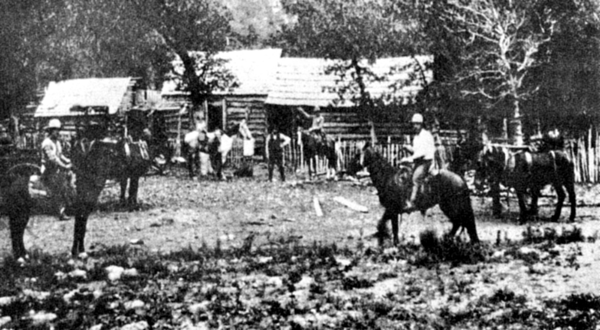
Belle Starr's cabin? There is no date or information on the source of the photo. What appears to be a bluff is visible behind the middle cabin, not a feature found at Younger's Bend. This may be a frame from the silent movie, COURT MARSHAL. The cowboys look suspiciously Hollywood. None of the buildings resemble those known to be of Belle's cabin at Younger's Bend. |
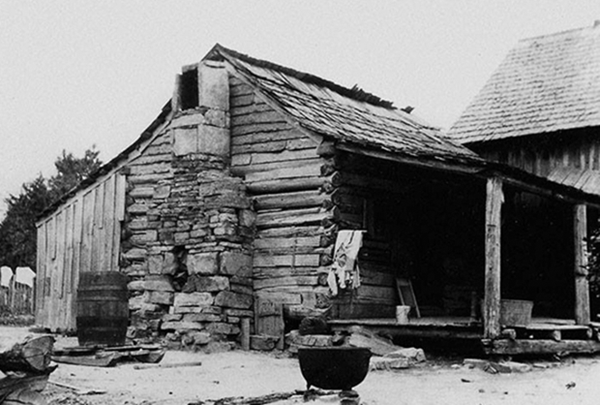
Compare this photo to the one showing her tomb. This picture may actually be of Belle's cabin while she was alive. Her tomb should be conspicuous from this angle. The photo is undated. |
|
A picture of Belle Starr's tomb; the headstone and the rocks forming the tomb are chipped and weathered indicating this picture was taken long after her death. The damage was done by souvenir hunters. |
Notice the differences in the headstone compared to the one on the left in this picture of the tomb taken before the cabin and barn were demolished. Nothing remains of the buildings. |
|
Undated photo. Compared to the photo above, this stone seems to be in good shape except for some chipping on the edges, some of which can be seen in both photos. |
||
Page 16, May 22, 1886, issue of the National Police Gazette captioned, A WILD WESTERN AMAZON. THE NOTED BELLE STARR IS ARRESTED ON THE BORDER OF INDIAN TERRITORY AND BEING RELEASED ON BAIL VANISHES ON HORSEBACK. The arrest and bail reported by the Police Gazette pertained to the Middleton affair. Belle naver vanished, she returned to Younger's Bend.
|
||
1899 Fort Smith newspaper ad for Pearl's bordello |
A young Pearl Starr |
|
Rose Lee Reed - "Pearl Starr". Pearl was born September, 1868 in Rich Hill, Missouri; She was married four times and had three children by two different husbands. She died on July 6, 1925 in Douglas, Arizona. |
Ed Reed (on the right). This studio picture was taken at the W.H. Catterlin studio in Claremore, Indian Territory. |
|
Sources:Glenn Shirley,Law West of Fort Smith, University of Nebraska Press, Lincoln, NE., 1957 Carol Tallman Jones, DESPERADO, The Infamous Belle Starr, Geocities/Heartland/Plains/bstarr (1997) Richard D. Arnott, Bandit Queen Belle Starr, The HistoryNet.Com Copyright ©2006 Weider History Group; 1850 U.S. Census, District 41, Jasper County, Missouri, pg. 76, family 518, John Shirley; Ancestry.com 1850 U.S. Census, District 6, Bates County, Missouri, pg. 258b, family 400, Solomn and Susan Reed (Jame Reed); Ancestry.com 1860 U.S. Census, Little Oage Township, Vernon County, Missouri pg. 104, family 720, Solomon and Susan Reed; Ancestry.com 1860 U.S. Census, Marion Township, Jasper County, Missouri, pg. 827, family 426, John and Eliza Shirley (Myra Shirley); Ancestry.com 1870 U.S. census,11 August 1870, Los Nietos, Los Angeles County, California, pg. 584, family 233, Jim and May Reed; Ancestry.com 1900 U.S. Census, Upper Township, Fort Smith, Arkansas, pg. 259, line 368, Pearl Starr, Prostitute; Ancestry.com 1910 U.S. Census, Winslow, Washington County, Arkansas, ED 153, Sheet 9B; Pearl Andrews (two daughters Ruth and Jennetta); Ancestry.com The Encylopedia of Arkansas History, Belle Starr, AKA Myra Maybell Shirley, http://www.encyclopediaofarkansas.net/encyclopedia/entry-detail.aspx?entryID=2406 National Park Service, Pearl Starr, Juliet Galonska, April, 1996, https://www.nps.gov/fosm/learn/historyculture/pearl-starr.htm Grand Lake News Online, Grand Lake, Oklahoma, "Ed Reed Gone Right", http://grandlakenewsonline.com/ed-reed-gone-right-p1771-126.htm The Portal to Texas History, Ed Reed and Edward Clark, https://texashistory.unt.edu/ark:/67531/metapth12307/ |
||
| <<=PREVIOUS | NEXT=>> | |
Ronald N. WallModified: 11 July 2020 |